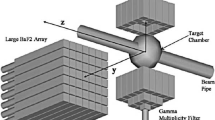Summary
It is shown that Walecka’s version of the Goldhaber-Teller model of the «giant dipole» nuclear collective oscillations, generalized to spin-isospin vibrational modes by the author, may be used to describe the gross features of the inelastic electron scattering results in a semi-quantitative manner. We have obtained simple expressions for the longitudinal and transverse matrix elements leading to electric dipole (1−) and magnetic quadrupole (2−) collective states in12C and16O. The decay widths of these states were calculated also, using Wigners.R-matrix theory, and are generally in good agreement with the observed widths.
Riassunto
Si mostra che la versione di Walecka del modello di Goldhaber-Teller delle oscillazioni mzcleari collettive di «dipolo giganteα, generalizzata dall’autore ai modi vibrazionali spin-isospin, può essere usata per descrivere in modo semiquantitativo le caratteristiche grossolane dei risultati dello scattering elettronico anelastico. Si sono ottenute semplici espressioni degli elementi di matrice longitudinale e trasversale che portano a stati collettivi di dipole elettrico (1−) e quadrivpolo magnetico (2−) nel12C e nel16O. Si sono calcolate anche le ampiezze di decadimento di questi stati, con la teoria della matriceR di Wigner, ed esse sono generalmente in buon accordo con quelle osservate.
Similar content being viewed by others
References
E. Hayward:Rev. Mod. Phys.,35, 324 (1963).
M. Goldhaber andE. Teller:Phys. Rev.,74, 1046 (1948).
W. Wild:Bayr. Akad. Wiss. Math.-Naturw. Klasse,18, 371 (1956);S. Fallieros, E. A. Ferrell andM. K. Pal:Nucl. Phys.,15, 363 (1960);A. E. Glassgold, W. Heckrotte andK. M. Watson:Ann. Phys.,6, 1 (1959).
E. P. Wigner:Phys. Rev.,51, 106 (1937).
L. L. Foldy andJ. D. Walecka:Nuovo Cimento,34, 1026 (1964).
J. Goldemberg, Y. Torizuka, W. C. Barber and J. D. Walecka:Nucl. Phys.,43, 242 (1963).
H. Überall:Phys. Eev.,137, B 502 (1965).
F. H. Lewis:Bull. Am. Phys. Soc.,10, 583 (1965). It appears that results of Lewis’ model, which was not formulated using density matrices, and whose connection with the nuclear matter results (3) is thus less obvious, differ from ours by a factor 3. I wish to thank Dr.Lewis for a discussion on this point. One should also note that the vector and axial vector muon capture matrix elements in our model satisfy Tolhoek’s relation, eq. (22) of ref. (7), and thus the magnetic sum rule of ref. (13) (if the levels are taken as degenerate).
H. Überall:Phys. Rev. 139, B 1239 (1965).
H. Überall:Nuovo Cimento 38, 669 (1965).
E. Boeker:Thesis, University of Amsterdam (1963) (unpublished).
J. Goldemberg andW. C. Barber:Phys. Eev.,134, B 963 (1964).
T. de Forest jr.,J. D. Waleoka, G. Vanpraet andW. C. Barber:Phys. Lett.,16, 311 (1965).
J. M. Wyckoff, B. Ziegler, H. W. Koch andR. Uhlig:Phys. Eev.,137, B576 (1965).
F. H. Lewis jr. andJ. D. Walecka:Phys. Rev.,133, B 849 (1964).
A. E. Edmonds:Angular Momentum in Quantum Mechanics (Princeton, 1957).
V. Gillet andN. Vinh Mau:Nucl. Phys.,54, 321 (1964).
T. de Forest jr.:Phys. Bev.,139, B 1217 (1965).
F. H. Lewis jr.:Phys. Bev.,134, B 331 (1964).
In ref. (9), the tentative assignment (1p 3/2)−1(1d 3/2) was made for this state In the light of the new result of ref. (13,19), the present assignment seems to be the more correct one.
This identification is based solely on the fact that in the collective model, different types of transitions receive their strength from different states exclusively, in the particle-hole model predominantly (the residual interaction tends to concentrate transition strength intoone out of several possible states). It is not clear whether a more direct connection exists between the two models (especially in view of the fact that the collective model rests on LS type coupling, the particle-hole model onjj coupling. I am indebted to Dr.M. Danos for comments on this point).
J. E. Monahan, L. C. Biedenharn andJ. P. Schiffer: Argonne National Laboratory report ANL-5846 (1938).
W. T. Sharp, H. E. Gove andE. B. Paul: Chalk River Report AECL-268 (reprinted 1965).
S. Penner andJ. E. Leiss:Phys. Bev.,114, 1101 (1959).
H. Fuchs, D. Haag, K. H. Lindenberger andU. Meyer-Berkhout:Zeits. Naturfors.,17a, 439 (1962);H. Fucus andD. Haag:Zeits. Phys.,171, 403 (1963).
E. C. Halbert andJ. B. French:Phys. Bev.,105, 1563 (1957).
P. F. Yergin, E. H. Augustson, N. H. Kaushal, H. A. Medicus, W. E. Moyer andE. J. Winhold:Phys. Bev. Lett,12, 733 (1964).
The question of the factor-2 discrepancy in particle-hole calculations is discussed in ref. (15,19). It essentially comes about by the use of the harmonic oscillator level energy in the transition strengths as calculated by these authors (l5), whereas current conservation (Siegert’s theorem) requires that the experimental transition energies should be used. Since Siegert’s theorem, an exact relation, should be valid for small momentum transfers, the particle-hole transition strengths have only qualitative significance. Cf. the correcponding remarks of ref. (30).
M. Danos andE. G. Fuller:Ann. Rev.Nucl.. Sci.,15, (1965) (to be published). in the chapter entitledQualitative Features of the Results of Shell Model Calculations.
Author information
Authors and Affiliations
Additional information
Supported in part by the National Science Foundation.
Rights and permissions
About this article
Cite this article
Überall, H. The giant resonance in inelastic electron scattering. Nuovo Cimento B (1965-1970) 41, 25–36 (1966). https://doi.org/10.1007/BF02711112
Received:
Published:
Issue Date:
DOI: https://doi.org/10.1007/BF02711112




